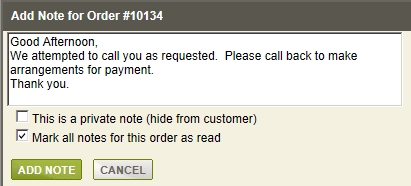Manage > Orders > View Order # > History and Notes
Order Notes
Order History
When an order is placed, paid, and shipped, there will be a number of events that are automatically recorded as part of the order's history. The notes written to the order can vary, but typically occur when a payment is made, balance is due, money is refunded, a status changes, and shipments occur.
These entries will always remain hidden from the customer's view and they are not editable by the merchant.
View the Order History
To view an order with events recorded, you should pick one that has been paid and shipped.
From the History and Notes page, you will see a page that looks similar to the example below.

The type of information recorded depends on what action is being taken with the order. Typical actions recorded here are as follows:
New order placed - The order as been submitted. (All new orders will have this event.)
Order paid in full - The order has been paid, no balance remains. (Partial payments will trigger an event logged to the history page as well.)
Pending shipment - The order status has been changed from Payment Pending to Shipment Pending. (After an order is paid, and there is a shipment, this will automatically trigger an event logged to the history page as well as change the order status.)
Order shipped - The order has been shipped. (Once the order is marked as shipped, it will be logged. Any partial shipments will be shown as well.)
Order completed - The order status has been changed from Shipment Pending to Completed. (After an order is paid and shipped, it will automatically trigger an event and the order status will be changed to Completed.)
NOTE: The order history events will be never be shown to the customer.
There are two types of information logged in the Order History and Notes. Automated entries, or historical logs, are shown when any action takes place with the order such as payment, shipping, etc. Then there are notes, or manual entries, which can be input by the customer or the merchant.
If a merchant enters a note, there is an option to keep it hidden (private) from the customer's view or shown on the customer's order. Additionally, a customer may view their order to send a message to the merchant.
If public comments are entered by the merchant or the customer, an email can be triggered to send notification to both.
Add an Order Note
From the History and Notes page, you will see a page which records all the events that take place for an order.
If you want to add a note to the order, click the ADD COMMENT button to view a pop-up form.

Type your message into the field. By default, all comments are private (hidden from customer).
If you want to add a note so the customer can view it on their order, then uncheck the box next to 'This is a private note'.
The option to 'Mark all notes for this order as read' will be checked by default. You can uncheck this box if you want the prior notes to remain unread.
When finished, click the ADD NOTE button.
Edit an Order Note
From the History and Notes page, find a note with an EDIT and DELETE icon in the last column of the row.

Click the EDIT icon to view the note in a pop-up form.
Change the comment text as needed and click SAVE.
If you wish to change whether or not the note is private or public. Check the box so the note is for internal viewing only, or un-check it so that a customer can view it on their order.
If you un-check the box to make this a public note, it will appear on the customer's order invoice.
Click the SAVE icon when finished, or the CANCEL icon to quit without saving.
TIP: The default data from the store installation includes two email templates that have triggers for the order notes. This will automatically send email when the merchant or the customer adds notes to the order.
What does the customer see on their invoice?
After the customer places an order, they can add a note or reply to a merchant's note.

When the customer submits their note, an email notification can be sent to the merchant.
If you want to disable the ability for customers to submit notes, you can do so from the Configure > Store > Order Settings page.
Related Topics
Manage > Orders
> Order History
Automatic recorded events related to order processing.
Configure
> Email > Templates
Generate email messages which can be sent automatically when certain
events occur.